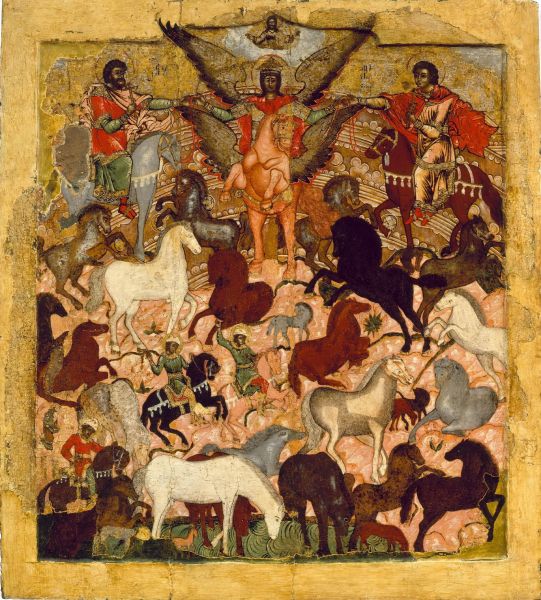|
|
The Archangel Michael’s Miraclewith Florus and Laurus. Late 17th – early 18th century

Levkas and tempera on wood
77 х 70 х 2
State Russian Museum
Annotation
Russian North
According to their vita, Sts Florus and Laurus weretwin brothers who lived in 2nd-century Illyria,where they worked as builders and stonemasons.The prefect of Illyria, Likaion, entrusted the saintswith the construction of a temple of Heracles.However, after first converting the workers toChristianity, they built a Christian church instead,smashing the pagan idols and erecting a cross atthe temple’s eastern wall.While it was being constructed, the saints healed the pagan priest Mamertin’s son Anastas’ eye, which had been injured by a flying piece of brick. Then the Lives of the Saints speaks of the torture Florus and Laurus endured and their execution. Russian icons of thesaints, of which many survive, don’t reflect theirveneration as patrons of stonecutters. Instead,these icons depict the Archangel Michael’s Miraclewith Florus and Laurus, in which the saints appearas protectors of horses and domestic livestock.Florus and Laurus often are depicted in icons with the archangel Michael. According to one popular belief, one day, shepherds turned to the saints for help in returning their lost horses. And they in turn prayed for the archangel Michael to help them. According to another interpretation, the archangel Michael announces the finding of the relics of the holy martyrs, thanks to which horses stop dying. Their feast day, 18 August, was known inRus as the “horse holiday”. On this day horsesweren’t used to perform labour; instead, they werelovingly adorned, bathed, watered and then ledto church for a public prayer service. The holiday ended with horse rides and races. The veneration of Laurus and Florus as saints and patrons of horses, arose in the Balkans (Illyria), where it replaced the classical cult of the horsemen Castor and Pollux. The iconographiccomposition of the Archangel Michael’sMiracle with Florus and Laurus became especiallywidespread in northern Rus, i.e. Novgorod andits northern provinces.

